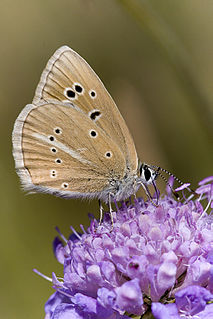
Desidae is a family of spiders, some of which are known as intertidal spiders. The family is named for the genus Desis, members of which live in a very unusual location — between the tides. The family has been reevaluated in recent years and now includes inland genera and species as well, such as Badumna and Phryganoporus. In 2017, the family Amphinectidae was merged into Desidae. The family Toxopidae has been separated off. Those intertidal spiders that are truly marine commonly live in barnacle shells, which they seal up with silk; this allows them to maintain an air bubble during high tide. They emerge at night to feed on various small arthropods that live in the intertidal zone.

The chalkhill blue is a butterfly in the family Lycaenidae. It is a small butterfly that can be found throughout the Palearctic realm, where it occurs primarily in grasslands rich in chalk. Males have a pale blue colour, while females are dark brown. Both have chequered fringes around their wings.

Stiphidiidae, also called sheetweb spiders, is a family of araneomorph spiders first described in 1917, Most species are medium size and speckled brown with long legs. All members of this family occur in New Zealand and Australia except for Asmea. They build a horizontal sheet-like web under rocks, hence the name "sheetweb spiders".

Cycloctenidae is a family of spiders first described by Eugène Simon in 1898.

Polyommatus is a diverse genus of butterflies in the family Lycaenidae. Its species are found in the Palearctic realm.

Kretania is a genus of butterflies in the family Lycaenidae.

Polyommatus (Agrodiaetus) fulgens is a species of butterfly in the family Lycaenidae. It is found in the north and north-east of Spain.
Polyommatus actinides is a butterfly of the family Lycaenidae. It was described by Otto Staudinger in 1886. It is found in central Asia.

Polyommatus admetus, the anomalous blue, is a butterfly of the family Lycaenidae. It was described by Eugenius Johann Christoph Esper in 1783. It is found in south-eastern Europe and Turkey.
Polyommatus afghanistana is a butterfly of the family Lycaenidae. It was described by Walter Forster in 1972. It is found in Afghanistan.
Polyommatus altivagans is a butterfly in the family Lycaenidae. It was described by Walter Forster in 1956. It is found in Asia Minor, the eastern Caucasus and Transcaucasia.
Polyommatus aserbeidschanus is a butterfly in the family Lycaenidae. It was described by Walter Forster in 1956. It is found in the Caucasus, Armenia and Turkey.
Polyommatus (Agrodiaetus) ninae, or Nina's blue, is a butterfly of the family Lycaenidae described by Walter Forster in 1956. It is found in Armenia, Azerbaijan, Georgia, eastern Turkey, and northern Iran (Kurdistan).

Toxopidae is a small family of araneomorph spiders, first described in 1940. For many years it was sunk into Desidae as a subfamily, although doubts were expressed as to whether this was correct. A large-scale molecular phylogenetic study in 2016 led to the family being revived.








